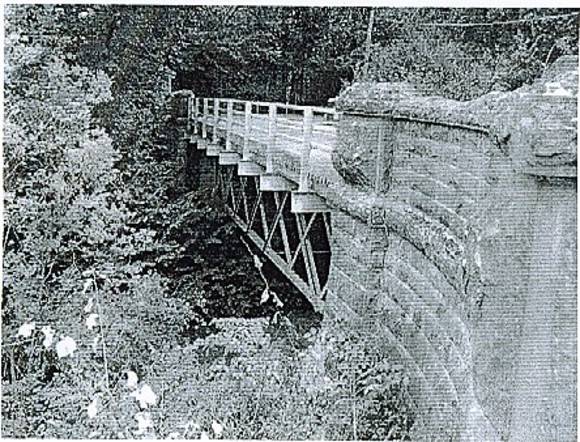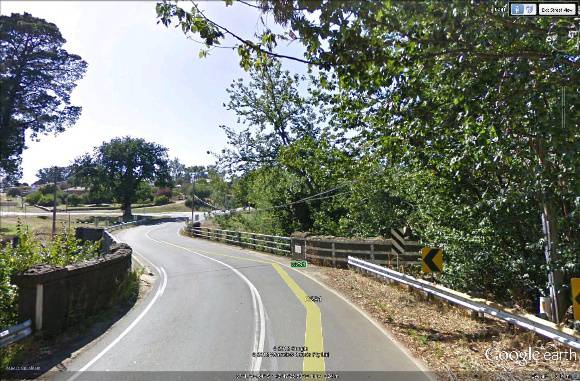| Back to search results » | Back to search page » |
|
Government Bridge over Creswick or Tullaroop Creek
LocationClunes-Creswick Road,, CLUNES VIC 3370 - Property No B7297
File NumberB7297LevelState |
|
Statement of Significance
What is significant? Government Bridge is a large iron truss and stone bridge at the entrance to Clunes Township built by the Borough of Clunes. The bridge has a single span of 23 metres over a deep section of Creswick or Tullaroop Creek. The abutments date to around 1857, while the trusses were erected in 1896, and the deck and handrails are modern.
How is it significant? Government Bridge is significant for aesthetic/architectural, historic, and scientific (technical) reasons at a State level.
Why is it significant? Government Bridge is of historical significance to Victoria in demonstrating the role of goldfields wealth in contributing to the development of roads and engineering standards in Victoria in the nineteenth century. The bridge was the main road entrance to this important early gold town from the 1860s (in its original laminated arch form), and played an important role in the communication and civic pride of the town throughout the second half of the nineteenth and early twentieth centuries. The reconstructed bridge reflected the brief revival of mining in the town at the end of the nineteenth century and an unusual optimism in the midst of the Great Depression. The bluestone abutments, and the evidence of the former laminated timber arch bridge, demonstrate the design standards and role of Public Works Department engineers in adapting English bridge models to Australia.
Government Bridge is one of only five lightweight metal truss design road bridges (along with Victoria Street Richmond, Brunton's Bridge, McMillan's Bridge and Pitfield Bridge), which were developed as a consequence of the theoretical and experimental engineering of the Melbourne University Engineering Department and its first Professor of Engineering W C Kernot from the early 1880s.
Government Bridge is also one of only a handful of bridges that demonstrate the use of laminated timber arches in bridge construction in the mid-nineteenth century. Others are Cressy, Pollocksford, Blue Bridge, Yendon, which were also converted to metal bridges. The continuous operation of the bridge through three major phases of building and modification contributes to its significance.
As a demonstration of both laminated arch and truss technology Government Bridge can provide evidence through further investigation, of the history of engineering and bridge design theories and technology in the nineteenth century. It therefore has a role in education, especially in conjunction with a number of other historical bridges in the district.
Government Bridge is of aesthetic significance both for its intrinsic design and for the setting. The rustic, but finely finished stonework of the abutments and wingwalls provide a suitable historic fabric for the entrance to Clunes, which is itself an exceptionally preserved nineteenth century townscape. The lightweight truss balances with the solid masonry to present a distinctive visual appearance from vantage points on the creek. The treed setting, which comprises mainly exotic (European) deciduous species, creates a pleasant and attractive framing for the bridge with foliage arching over the road and creek. This has been the character of the location since the early twentieth century when revegetation of the denuded mining landscape was undertaken as a civic project.
The bridge exhibits technical significance relating to two important engineering designs. The bluestone abutments demonstrate rare, if fragmentary evidence of laminated timber arch construction in the bearing surfaces for the arch springing. From these and other aspects of the abutments, it is possibly to deduce the form and dimensions of the arch span.
The metal truss is one of a small group of light weight riveted metal trusses which reflect the theoretical and experimental engineering designs of the Melbourne University Engineering Department and its first Professor of Engineering W C Kernot from the early 1880s. Beginning with the Victoria Street Bridge in 1880-84, designs were developed that incorporated scientifically calculated stresses and forces to determine with the most efficient use of materials and manufacturing techniques. Government Bridge stands in direct evolution from this bridge through Brunton's, McMillan's and Pitfield bridges. While it is not unusually long for a truss bridge, the combination of length with such a lightweight structure is an outstanding feature.
The bridge is rare in terms of the development of metal bridges in Victoria as it is one of few truss bridges built in the 1890s, and so is rarer than the more significant 1860s-80s examples.
The bridge is of social significance for the continuing awareness of local residents that the Government Bridge is part of the historical townscape of Clunes as well as a link beyond the town and tourist attraction, among the other goldfields relics.
Classified: 29/11/2004
Group
Transport - Road
Category
Road Bridge





